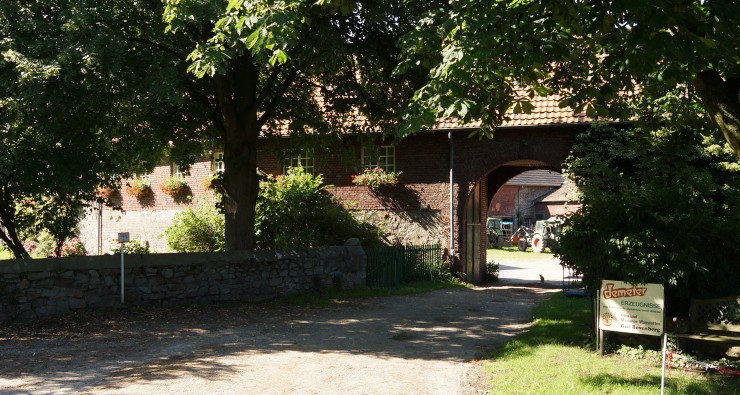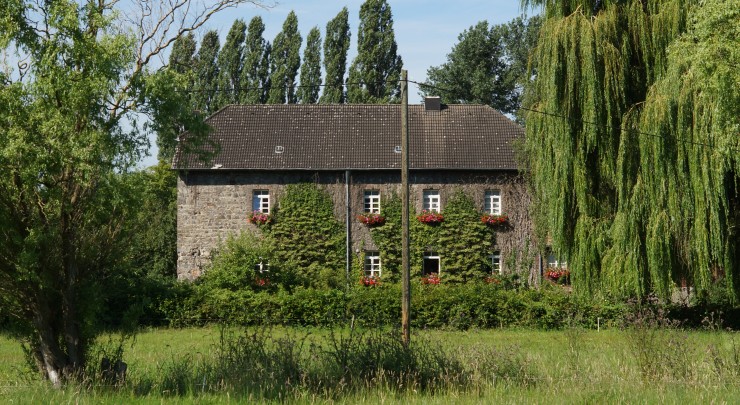IN THE THIRD BATTLE OF AACHEN
16 November to 3 December 1944
By Gerhard Engel, Generalleutnant a.D.
19 November
On the division's right sector, the Stolberg area, the Americans captured the Donnerberg mountain and the village of Duffenter on 19 November on the opposite side of Stolberg, the 3d Panzer Grenadier Div also lost ground. Since Stolberg was held, a vulnerable nose-like protrusion existed on the right wing. To avoid encirclement of the Füsilier-Regiment 27 in the northern part of Stolberg, the division withdrew the front here and moved into a prepared position at the northern edge of Stolberg.

In the afternoon of the 19th, strong attacks were again launched against Hill 232, a key point in the sector. As on the previous day, the fusilier battalion defended the peak stubbornly.
The arrival of the "Combat Team Baier" was delayed, jeopardizing the corps plans. If the Americans had not concentrated their attacks on Hill 232, but had continued to attack beyond Hamich toward Wenau, a breakthrough would doubtlessly have been successful; the road toward Langerwehe trough Wenau was unguarded. The combat team reached the assembly area near Heistern by morning and in spite of strong fighter bomber attacks, launched its counterattack toward Hamich at 1400 according to plan. In the beginning the attack, which doubtlessly surprised the Americans, developed well. Hamich was recaptured, but the attack to the south was stopped by a concentrated fire barrage and tank reinforcements moving up from Gressenich. Hamich was held that day only with great effort. For the attack, and its ultimate target of Gressenich, our tank and mounted infantry forces were too weak.
At 2400 the 47. Volksgrenadier-Division took over its sector; the withdrawal of the remaining units of the Grenadier-Regiment 48 and the Füsilier-Battalion 12, which was badly damaged, was set for the following night. Moving up to the left sector, the Wenau forest, of the 47. Volksgrenadier-Division was the 115th Inf Regt. The following boundary was ordered by the LXXXI Corps between the 12. Infanterie-Division (GE) and the 47. Volksgrenadier-Division: Merken (47. Volksgrenadier-Division) - eastern edge of Luchem -western edge of Langerwehe - western edge of Bovenberg forest -Scherpenseel (47. Volksgrenadier-Division) - Niederhof (12. Infanterie-Division (GE)) - southern edge of Stolberg. The "Combat Team Baier" remained subordinate to the 12. Infanterie-Division.
20 November
On 20 November the pressure of the enemy against the right wing increased with violent attacks on both sides of the autobahn. A bitter battle raged for the possession of the groups of pillboxes near Wambach, occupied by the Füsilier-Battalion 27. In the sector of the right adjacent division enemy pressure increased toward Weiden; ground was also lost there.
During the morning the enemy pressed again toward Eschweiler. The Grenadier-Regiment 89 repelled the attacks against Scherpenseel at first, but soon had to give up the village. Units of the Grenadier-Regiment 103, which was also defending the village, suffered heavy damage. The Füsilier-Battalion 12, which was defending Hill 232, was finally exhausted and lost the height in the early afternoon. Hamich was lost again. Several attacks against Heistern were repulsed by units of the Grenadier-Regiment 48, tanks of Combat Team Baier, and units of the 104th Grenadier Regiment. The 47. Volksgrenadier-Division withstood heavy fighting in the Wenau forest, but gave ground in the direction of Wenau.
By the evening of 20 November the remaining units of the Grenadier-Regiment 48 were withdrawn and assembled in the Langerwehe area to await orders from the LXXXI Corps. After the heavy fighting for Hill 232, the Füsilier-Battalion 12 was dispersed and ordered to assemble in the Lamersdorf - Frenz area. In the evening the corps ordered the quick transfer of "Combat team Baier" from the division to the 116th Panzer Div. The LXXXI Corps further ordered the Grenadier-Regiment 48 transferred to the right adjacent unit in the Schleiden area, where the situation had become particularly dangerous because of a breakthrough toward Jülich. During the night this regiment, which had just taken part in major fighting, was loaded on vehicles and driven toward Schleiden to be used in a counterattack in the sector of the heavily battered 183. Infanterie-Division.
21 November
For two days, 21 to 22 November, the Grenadier-Regiment 48 was involved in heavy fighting in the Schleiden area. Using assault guns of the 12. Infanterie-Division (GE), the regiment recaptured Schleiden and the neighboring area, preventing at the last moment a breakthrough toward Jülich. Since not enough forces remained in the regiment for an other attack or defense missions, the remaining units were withdrawn on 23 November and again transferred to the rear as corps reserves. The regiment was no longer of any combat value.
In the 4. Panzerjäger Kompanie (Sturmpanzer) the loss of 6 of its 10 tanks coupled with casualties, rendered the company useless for further operations during the third battle of Aachen. The Tiger Abteilung 506, an Army battalion, also suffered heavy losses while covering the withdrawal of the Grenadier-Regiment 48. The battalion performed this task magnificently, proving an essential factor in the closing the gap near Schleiden and the prevention of the breakthrough to the Roer at this spot.

Panoramic view towards Bovenberg Forest
Pano taken from the road Hamich - Heistern
On 21 November the attacks continued on a wide front. The new left sector of the division was jeopardized when the Americans gained ground against the greatly exhausted Grenadier-Regiment 103 and advanced toward the Bovenberg Forest. Bitter fights were waged here in the C-line, which was not protected by wire and mine obstacles, but merely a continuous trench. All day the enemy attempted to take Hastenrath. It was obvious that the objective was the capture of Eschweiler from the west, that is, north of the Reich forest, and from the south through Hastenrath. On the central sector of the 47. Volksgrenadier-Division, near Hamich and Hill 232, the American attack was stopped. As a result of the heavy fights of the preceding days, the American forces were apparently too weak to count more than weak attacks. In the division sector the main thrust was from the south through the Eschweiler forest. In this area, where the view was obstructed by scattered underbrush, bitter close combats raged. In the evening Hastenrath was lost; Volkenrath which was situated to the north, was being held as a strong point by stubborn grenadiers of the 89. Regt and panzerjaeger troops. Serious penetrations in the sector of the left adjacent Grenadier-Regiment 103 clouded the situation, but the villages of Nothberg, Volkenrath, and Buschhof the western edge of the Bovenberg forest remained in our hands. Our divisions and the 47. Volksgrenadier-Division succeeded in building up a thin defense front of strong points. The Füsilier-Regiment 27 was holding the western and southwestern edges of Eschweiler after having been pushed back during the day. Some strong points were in this sector. In the complicated mass of houses and industrial plants within the town, the enemy was following hesitantly, continually delayed by mine obstacles and casualties.
In the evening the division received permission from the corps to abandon Eschweiler in order to save the Füsilier-Regiment 27 and Grenadier-Regiment 89 there from encirclement, for they represented the bulk of the existing infantry force. The commander of the 5th Panzer Army Headquarters voluntary took over the responsibility for this withdrawal, which had not received approval of Hitler's Headquarters. This move was the the only way possible to keep the division together and to give it the defense power needed for the coming dreadful battle of materiel. The evacuation of Eschweiler was to be completed during the night. Small rear parties were to keep contact with the enemy to prevent an early realization of the evacuation.
During the evening the situation became increasingly serious for the troops in and around Eschweiler because the pressure against the town increased from the south. Here the remainder of the Grenadier-Regiment 89 and the 12th Antitank Bn were fighting desperately against an enemy that was constantly receiving reinforcements. Moreover, fresh tanks had been thrown into the battle. From the slopes near Hastenrath the enemy controlled the southern edges of Eschweiler and the area to the east, making movement along the road Weisweiler - Eschweiler impossible by day. A counter-thrust by the antitank unit, using the last 4 guns of the 3d Assault-Gun Company brought some initial success and relief for a short time. In addition, a few American tanks were disabled. Nevertheless, the Americans advanced through Volkenrath and Bohl, taking the village of Bergrath and pushing ahead as far as the railroad Düren -Eschweiler. The railroad embankment was held with great effort, while a thin defense line was being built. Two batteries of the 12th Arty Regt, which were not permitted to change positions because of the low fighting power of the remaining infantry, were located at the embankment. Standing almost in the front line, the regiment formed the backbone of a defense front that had been improvised with meager insufficient material.
Because of the stubborn battles of the previous day, which had caused many losses on both sides, the enemy attacks were rather weak on the entire front. The division gained valuable time. Completely undisturbed, the Füsilier-Regiment 27 and Grenadier-Regiment 89 mined Eschweiler, reorganize and regrouped. Rear-guard units were so built up in the former MLR that the reorganization was screened. Single thrusts by the Americans were cleverly repulsed, giving the impression that Eschweiler, which was prepared for defense, was fully occupied. The MLR was held, mainly because the enemy attacks became weaker. It was even possible to hold the MLR in the western sector and make firm contact with the 47. Volksgrenadier-Division west of the Bovenberg farm.

Bovenberg Farm (2014)


